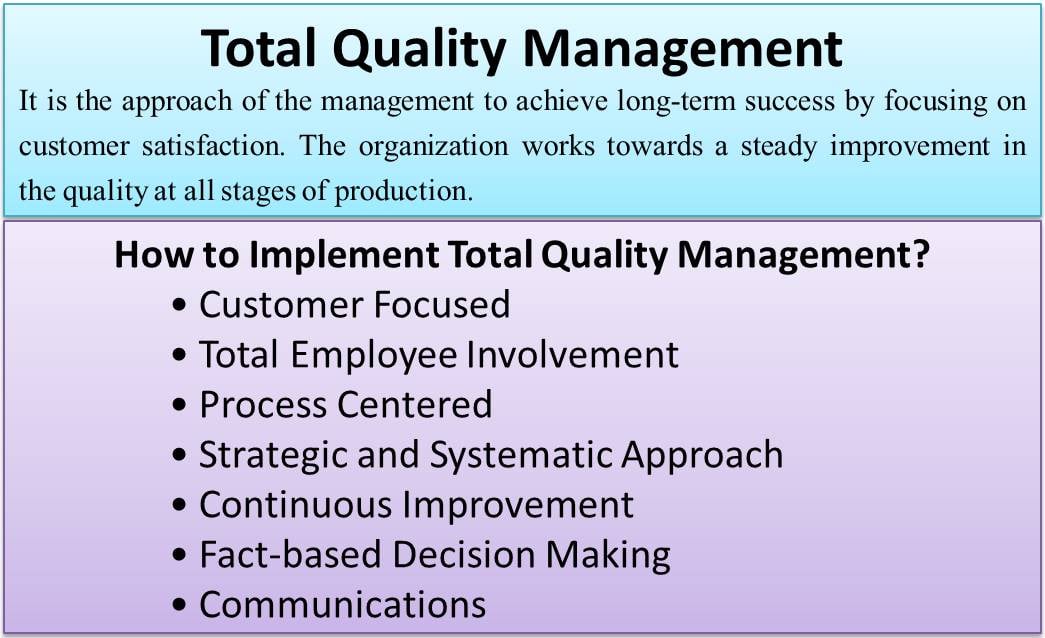Definition of Total Quality Management
Total Quality Management (TQM) is also referred to as total productive maintenance. It is the approach of the management to achieve long-term success by focusing on customer satisfaction. The organization works towards a steady improvement in quality at all stages of production. TQM also helps reduce risks in manufacturing, improve the customer experience, and ensure that the employees are well-versed and up-to-date with their training. TQM holds every individual accountable for the overall quality of the production.
After understanding TQM, let’s have a look at how to implement the same.
How to Implement Total Quality Management?
The following are the ways of implementing TQM in an organization:
Customer Focused
The customer experiences and judges the level of quality. An organization may invest in a number of methods such as upgrading software and computers, training employees, buying new measuring tools, or integrating quality into the design process. This would improve the overall production quality of the products, thereby leading to higher customer satisfaction.
Total Employee Involvement
All employees should contribute in achieving a common goal. A proper environment in the management and fear-driven from the workplace will help attain total employee commitment. Normal business operations should be integrated with high-performance work systems to achieve steady improvement.

Process Centered
Process evaluation can contribute in gaining TQM. A process involves taking inputs from internal as well as external suppliers. These inputs are later converted into outputs and delivered to the customers.
Strategic and Systematic Approach
Implementing a strategic and systematic approach will help gain an organization’s mission, vision, and goals. Formulating a strategic plan that focuses on quality is referred to as strategic management or strategic planning.
Continuous Improvement
Continuous process improvement helps drive TQM to a great extent. A requirement for continuous improvement drives an organization to find creative and analytical ways to handle stakeholder expectations effectively.
Fact-based Decision Making
Data on performance measures of the organization should be collected regularly. Consistent analysis of the collected data improves decision-making accuracy and permits future predictions on the basis of past history.
Communications
Effective communications boost employee motivation and maintain good morale in the organization. Effective communication should be a part of not just the times of organizational change but also as a part of day-to-day activities and operations.
The above process can be accomplished using the tools for TQM mentioned hereunder.
Tools for Total Quality Management
The following are the basic tools for achieving TQM:
Cause-and-Effect Diagram
Cause-and-effect diagram assists in identifying the possible causes for an effect and sorts ideas into suitable categories.
Check Sheet
A check sheet is an organized and arranged form for accumulating data. This tool can be utilized for a number of purposes.
Control Charts
The changes in the process over time are portrayed in control charts.
Histogram
A histogram portrays frequency distributions and determines how often a specific value occurs in a set of data.
Pareto Chart
The pareto chart is a bar graph displaying more significant factors over the rest.
Scatter Diagram
A Scatter diagram shows pairs of numerical data with variables on a different axis to determine relationships.
Stratification
The technique of bifurcating data accumulated from various sources so that Stratification can spot patterns.
Total Quality Management Examples
TQM at Ford Motor Company:
Ford Motor Company implemented TQM practices in the 1980s. They adopted the slogan “Quality is Job 1”. Ford later entered into a partnership with paint supplier ChemFil. The companies then worked towards producing a stable work environment, profitability, effective management, and better quality products. They later changed the slogan to “Quality People, Quality Products.” The organizations believed that a quality product that meets customer needs translates into financial success. This, in turn, helps in profit maximization.
Implementation of TQM made sure that processes at all stages of production were constantly developed upon, strictly followed, and improved time and again through customer quality satisfaction surveys.
Conclusion
Total Quality Management is a contemporary approach to the management of the whole organization. It ensures strict levels of quality at every stage of production. Therefore, if implemented strictly and correctly, it will lead to customer satisfaction, thereby leading to wealth maximization for the organization.


Good content which is worth reading. Thanks for info.
Very Good content which is worth reading it.Thanks
Good info which is worth reading it. Thanks
Great article with good information which is worth reading it. Thanks
Good content which is worth reading it.Thanks
The article is very informative which is worth reading it.
The presention is very simple but clear. Easily understood by layman. Great help for SMEs operators
Best Article which is worth reading it . Thanks for the information.